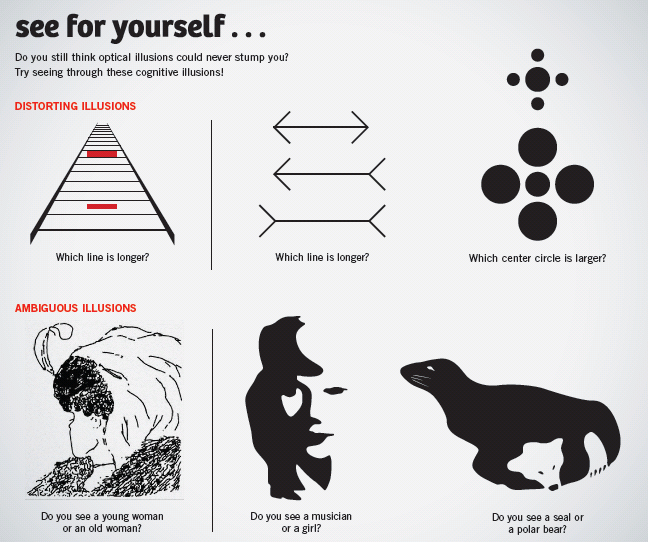
Experiment: What You See Isn’t Always What You Get
We rely on our sight more than any other sense to help us interpret our world. So when somebody plays a trick on our eyes, it can be quite disturbing. Can we trust anything we see? Why are our eyes so easily fooled?
The brain is often compared to a supercomputer. It can process an incredible amount of information in an unbelievably short amount of time. God specially designed our brains to instantly interpret pictures into a 3D world, even when they’re 2D. This, along with other traits of the brain, has inspired many of the illusions that we love so much.
Illusions that trick our eyesight, called optical illusions, take advantage of our brain’s ability to fill in gaps about the visible world. We don’t actually have to “see” everything to “get it.” Our brain processes information quickly, even when the information is incomplete. Normally that is a huge advantage. When we’re in familiar situations, our minds are especially good at making instant assumptions. Shapes and experiences from the past help form the way you think about the present. You are more prone to see what you expect.
Different types of illusions play off different patterns of thinking.
For example, a distorting illusion works because we assume that three-dimensional rules must apply to a two-dimensional picture. Take a look at the picture of train tracks (see below). This is known as a Ponzo illusion. Which of the two red lines is longer, the top or bottom? Keep in mind, the train tracks give the impression of depth.
If you measure them with a ruler, the two bars are the same length. The assumption of depth makes the line in the back appear farther away and the one in the front closer. This is why the illusion is so effective.
Another type of optical illusion is known as ambiguous. These illusions don’t play off the rules of geometry, like the former example. Instead, they play off what is most familiar to you. A common example is the line drawing of the lady that could be interpreted two ways. How old is the woman? Is she young and beautiful, or is she old and haggard? Once you know what to look for, you can see both images, but seeing both of them still takes work. For many people, it can take forever to see past the old woman’s nose!
Our brains become accustomed to certain common images in our surroundings. With so many other things that are changing in life, it is very helpful to detect predictable shapes, colors, and images. As we grow up, our brain is programed to see the familiar things first. They become the easiest for us to see. Without this design, we would suffer from information overload! (Everything would always seem new and unfamiliar. We would have to think about every color, shape, and sound just to know what it was.)
While these illusions are harmless enough, and can even encourage brain activity, they remind us that we must be wary. Since our mind automatically fills in the gaps, sometimes it can be wrong. We cannot rely on our own limited experiences and perspective to accurately fill in all the gaps.
That is why God has given us invaluable resources, through His Holy Spirit and His Word, to begin to see the world as He sees it (as it really is). That’s why He can say, “Be transformed by the renewing of your mind, that you may prove what is that good and acceptable and perfect will of God” (Romans 12:2).

Answers Magazine
April – June 2012
Now’s your chance to answer every question you ever had about cavemen! This issue is chock full of the latest information about Neanderthals, Homo erectus, “the Hobbit,” and other media stars. Were they like us? How did they die? Also learn about the wonders of the sun, creatures that glow in the dark, and the reason all Hebrew scholars agree that Genesis 1 says creation was six literal 24-hour days!
Browse Issue SubscribeRecommended Resources

Answers in Genesis is an apologetics ministry, dedicated to helping Christians defend their faith and proclaim the good news of Jesus Christ.
- Customer Service 800.778.3390
- © 2024 Answers in Genesis





